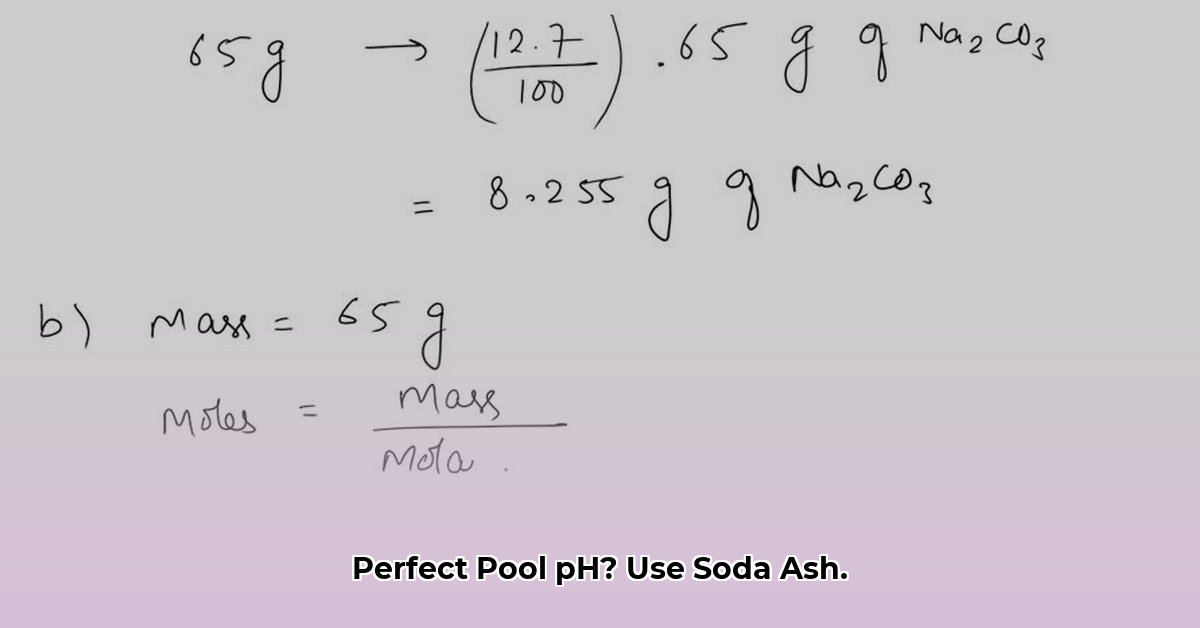Understanding Pool Water Chemistry
Crystal-clear, inviting pool water isn’t just about aesthetics—it’s about chemistry. Maintaining the right balance is key to swimmer comfort, equipment longevity, and sanitizer effectiveness. Sodium carbonate, commonly known as soda ash, plays a crucial role in this delicate balance. This comprehensive guide will equip you with the knowledge and practical steps to use soda ash effectively.
The Importance of Alkalinity
Think of alkalinity as your pool’s pH bodyguard. It acts as a buffer, preventing drastic pH fluctuations that can lead to a host of problems, from cloudy water and irritated eyes to scaling and inefficient chlorine. A healthy alkalinity level (generally 80-120 ppm) creates a stable environment, allowing your sanitizer to work optimally and protecting your pool investment.
The Role of Sodium Carbonate
Sodium carbonate is a powerful alkali—much stronger than baking soda—effective at raising both pH and total alkalinity. It’s your go-to solution when both these levels are low. The chemical reaction, evident by the fizzing when added to water, neutralizes acidity, bringing your pool closer to that ideal balance.
Achieving Balanced Water with Soda Ash: A Step-by-Step Guide
-
Test Your Water: Before any adjustments, use a reliable test kit to determine your pool’s current pH and alkalinity levels. This establishes a baseline for accurate dosage calculations. Different test types exist, from simple strips to digital readers, offering varying levels of accuracy.
-
Calculate the Dosage: Online pool calculators or charts on product labels provide precise dosage recommendations based on your pool volume and desired alkalinity increase. A rough estimate is six ounces of soda ash per 10,000 gallons of water to raise pH by approximately 0.2 and alkalinity by around 5 ppm. However, always prioritize calculator results for accuracy.
-
Safety First: Protect yourself by wearing safety glasses, gloves, and appropriate clothing before handling any pool chemicals. While sodium carbonate is generally safe, precautions are essential.
-
Dissolve the Soda Ash (for smaller pools): For smaller pools or for better dispersion, pre-dissolve the measured soda ash in a bucket of water drawn directly from the pool. This minimizes the risk of staining or localized high alkalinity. Important: Always add the chemical to the water, never the reverse. Do not exceed 15 lbs of soda ash per bucket to avoid potentially dangerous exothermic reactions. Consider using a sock or stocking to filter out undissolved particles.
-
Add to the Pool With the filter running, broadcast the soda ash across the water’s surface. Avoid dumping it in one spot, especially near the skimmer, to ensure balanced distribution.
-
Circulate and Retest: Run the pool pump for at least six hours, preferably overnight, to fully circulate the soda ash. Retest the water after 24 hours and make further adjustments as needed. Achieving perfect balance may require a few rounds of testing and minor tweaks.
Baking Soda vs. Soda Ash: Choosing the Right Chemical
Both baking soda (sodium bicarbonate) and soda ash (sodium carbonate) contribute to balanced pool water, but their strengths and applications differ:
| Feature | Baking Soda | Soda Ash |
|---|---|---|
| Primary Effect | Raises Alkalinity | Raises pH and Alkalinity |
| Secondary Effect | May slightly increase pH | N/A |
| When to Use | Low alkalinity, normal pH | Low alkalinity and low pH |
| Impact | Gentle adjustment | More significant adjustment |
Baking soda provides a gentle boost to alkalinity without significantly affecting pH. Soda ash is the more potent option, tackling both low pH and alkalinity concurrently.
Troubleshooting Common Issues
-
Cloudy Water: This often indicates excessive soda ash or insufficient pre-dissolving. Backwashing the filter and retesting are recommended. In some cases, a pH decreaser might be necessary to lower alkalinity and restore clarity.
-
pH Doesn’t Increase: Verify initial readings, retest, and consider adding more soda ash in smaller increments. Ensure alkalinity is within the correct range first, as addressing alkalinity sometimes allows pH to self-correct. High calcium hardness can also interfere with pH adjustment.
-
High Alkalinity: Though less common, high alkalinity can occur. Continuous filtration and adding fresh water to dilute the pool can help. Muriatic acid offers faster results but requires extreme caution and strict adherence to product instructions.
Tips and Best Practices for Maintaining Pool Chemistry
- Regular Testing is Key: Consistent monitoring, ideally weekly, allows for proactive adjustments and prevents imbalances from escalating.
- Gradual Adjustments are Best: Avoid drastic chemical additions. Smaller, incremental changes minimize the risk of overshooting target levels.
- Consult a Professional: While this guide provides comprehensive information, consulting a pool professional is always advisable, particularly for persistent issues or complex scenarios. They can offer tailored advice and expert analysis.
- Ongoing Research: Pool chemistry is a continually evolving field. Stay informed about the latest research and best practices to ensure optimal pool care.
By understanding the nuances of pool water chemistry and the role of sodium carbonate, you can confidently maintain a sparkling, balanced, and inviting pool throughout the swimming season. Remember that patience, consistent monitoring, and occasional adjustments are key to achieving and maintaining that perfect chemical harmony.
- Hydro Extrusions USA Leads North American Aluminum Profile Solutions - December 28, 2025
- Hydro North America Leads Aluminum Extrusion Solutions Across Diverse Industries - December 27, 2025
- Hydro Extrusion North America Provides Custom Solutions Across Diverse - December 26, 2025
















